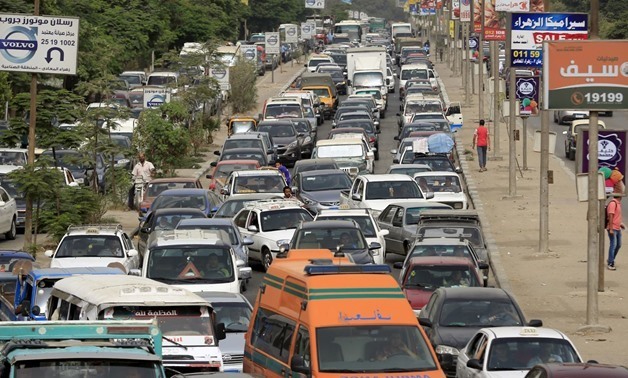
Motorists stuck in a traffic jam on the outskirts of Cairo. REUTERS/Amr Abdallah Dalsh
CAIRO – 18 November 2019: In February, a 29-year old man was found dead inside his car in Nozha district in Giza, with foam coming out of his mouth, with no sign of violence detected. The young man died of heroin overdose.
The rising numbers of new drugs introduced to the Egyptian illegal market are threatening thousands of youths’ lives amid difficulty to accurately determine its prevalence rate in the country. Vodoo, Strox and Blue Elephant are among the latest potent narcotics that emerged in Egypt, and are highly abused by many young people while behind the wheel.
Along the same lines, the government regularly launches sudden anti-drug campaigns across the country; one of them was last week, where drug tests were carried out on 225 drivers, of whom 34 tested positive to drug abuse.
When driving under the influence of drugs, the likelihood of accidents increases in different degrees according to the psychoactive substance used. For example, the risk of fatal accidents among amphetamine users is approximately five times higher than in others, said the World Health Organization (WHO).
According to the Weed Index 2018 report, Egypt came fifth in the rankings to cannabis consumption that hit 32.59 tons in 2018.
Tramadol is the most abused drug by drivers, followed by hashish and then heroin, according to Amr Othman, head of the anti-addiction fund in a previous interview.
Drugs are commonly classified into three categories: Natural drugs; synthetic, which refers to drugs that are chemically-created to be similar to other drugs; and digital drugs or I-dosing, which is also known as “binaural beat,” where auditory illusion using various frequencies produces a sedative effect.
Intensive anti-drug campaigns
In July, the General Directorate of Traffic launched several crackdowns to spot drivers under the influence, and the results showed that in one week 138 drivers out of 1,450 tested positive to drugs, which equals 8 percent of the examined drivers. Legal procedures were taken against them, as part of the government’s move to reduce road accidents due to driving under the influence.
The directorate reiterated its warnings to the risks of driving under the influence of narcotics, because “drivers cannot be fully focused, their reflex action diminishes, and become less capable to push the brakes or escape any friction with other cars on the road.”
"Approaching drug abuse and addiction issues have been a top priority in Egypt since 2014, after nation-wide studies have shown that 10.4 percent of Egyptians aged between 12 to 60 years old are abusing drugs, while addiction rates recorded 2.4 percent," said Member of Anti-Addiction Fund’s technical office Mahmoud Saleh in a TV interview in November.
Saleh added that Egypt’s drug abuse rates then were exceeding the global rates, which recorded between 4.5-5 percent.
A striking figure showed that the 27 percent of drug abusers in Egypt are women, while children (aged between 12 to 18 years old) constituted 4.2 percent of the abusers.
Government campaigns extended to detect drug abusers among public employees, where latest figures show 279 employees at administrative bodies tested positive to addiction.
In 2014, a national survey indicated that 24 percent of Egyptian drivers abuse drugs. The figures saw improvement in 2017, with only 11.8 percent of drivers testing positive for drugs, according to statistics provided by the state-run anti-addiction fund.
Officials attributed the reduction in car accidents to several bids launched by the government like anti-addiction awareness campaigns that flooded TV, improved infrastructure through maintenance of old roads and construction of new roads, besides concerted efforts to detect drug abusers.
The new traffic law, with its toughened punishment, imposes imprisonment of up to 3 years, withdrawal of the driver's license and a steep fine of up to LE 20,000 to drivers who test positive to drugs.
A new traffic draft law was discussed by the parliament, where violators will be imprisoned for six months or less, and will be fined not less than LE 4,000 ($223) and not more than LE 8,000 ($447), or they will face one of the two penalties, a security source said, adding that five points will also be deducted from the violating driver.
Minister of Social Solidarity Ghada Wali recently announced that the ministry managed “to reduce drug abuse rates among truck drivers from 24 percent last recorded in 2015 to 12 percent in 2019." The ministry also supported the traffic administration with 50,000 drug detectors over this year to assist in street campaigns.
Truckers comprise the biggest percentage of drug abusers as they claim drugs keep them alert, and make them bear the long driving hours. However, they are not the only drivers canvassed by the anti-drug driving campaign, which also targets bus and school bus drivers.

Comments
Leave a Comment